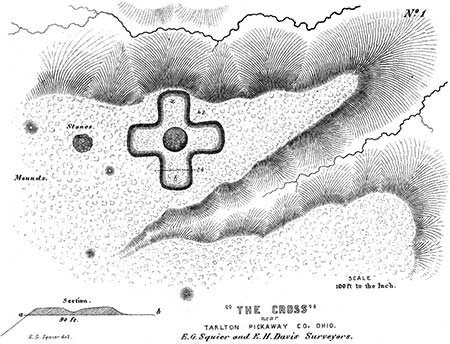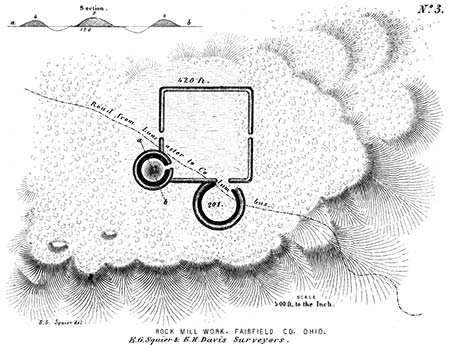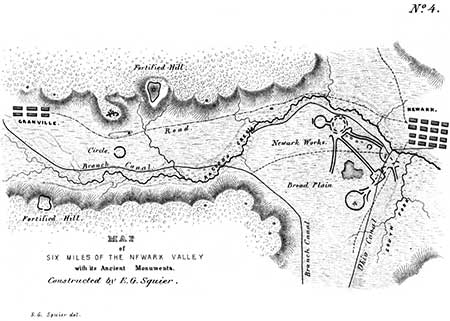PLATE XXXVI. No. 1.
"The Cross," Pickaway County, Ohio.
The work here figured is found near the little town of Tarlton, Pickaway county, Ohio, in the narrow valley of "Salt creek," a tributary of the Scioto river, eighteen miles north-east from Chillicothe, on the great road to Zanesville. In position it corresponds generally with the remarkable work last described, though wholly unlike it in form. It occupies a narrow spur of land, at a prominent point of the valley; its form is that of a Greek cross, ninety feet between the ends, and elevated three feet above the adjacent surface. It is surrounded by a slight ditch, corresponding to the outline of the elevation; in the centre is a circular depression, twenty feet across and twenty inches deep. The sides of the cross correspond very nearly with the cardinal points. Immediately back of it, is a small circular elevation of stone and earth, resembling that in connection with the Granville effigy, (No. 2 of the Plate,) and denominated an altar in the description of that work. Several small mounds occur near by; and upon the high hill, a spur of which is occupied by the cross, are several large mounds. Mounds are quite numerous in this little valley, and on the hills bordering it; but it is not known to contain any enclosures.>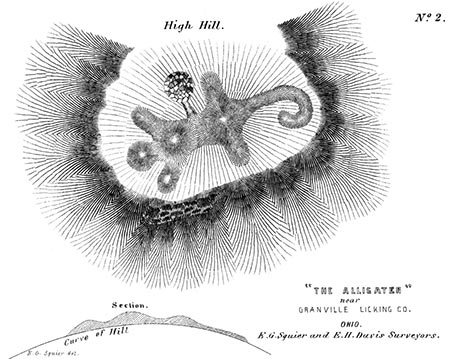 |
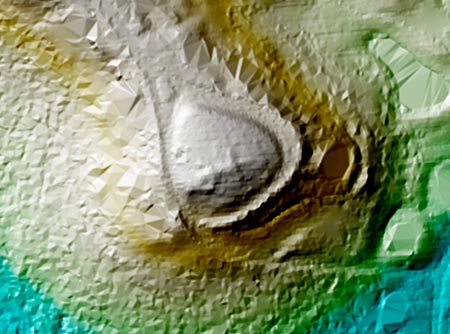 |
| Lidar image of alligator mound as it appears today. |
PLATE XXXVI. No. 2.
"The Alligator." Licking County, Ohio.
This strange work occupies a position somewhat analogous to that of the great serpent already described. It occurs about one mile below the town of Granville, Licking county, Ohio, upon a high and beautifully rounded spur of land, which projects boldly into the delightful valley of "Raccoon creek," a stream which, in conjunction with the "South fork," forms Licking creek or river, the principal tributary of the Muskingum. The hill or headland is one hundred and fifty or two hundred feet in height; and the effigy rests upon its very brow, conforming to its longitudinal as well as lateral curve. Its form is accurately indicated in the plan. It is known in the vicinity as "the Alligator;" which designation has been adopted, for want of a better, although the figure bears as close a resemblance to the lizard as any other reptile. It is placed transversely to the point of land on which it occurs, the head pointing to the south-west; its precise bearing is S. 67° W. The total length from the point of the nose following the curve of the tail to the tip, is about two hundred and fifty feet; the breadth of the body forty feet; and the length of the legs or paws, each thirty-six feet. The ends of the paws are a little broader than the remaining portions of the same, as if the spread of the toes had been originally indicated. The head, shoulders, and rump, are more elevated than the other parts of the body, an attempt having evidently been made to preserve the proportions of the object copied. The outline of the figure is clearly defined; its average height is not less than four feet; at the shoulders it is six feet in altitude. Upon the inner side of the effigy is an elevated circular space, covered with stones which have been much burned. This has been denominated an altar. Leading from it to the top of the effigy is a graded way, ten feet broad. The earth has been excavated at various points of the figure; but nothing was disclosed except the fact that the framework is composed of stones of considerable size. The superstructure is of fine clay, which seems to have been brought from a distance, as no signs of excavation are apparent in the vicinity.The headland upon which this effigy occurs is so regular as almost to induce the belief that it has been artificially rounded. Its symmetry has lately been somewhat broken by the opening of a quarry in its face, the further working of which will inevitably result in the entire destruction of this interesting monument.71 It commands a view of the entire valley for eight or ten miles, and is by far the most conspicuous point within that limit. Its prominence is, of necessity, somewhat exaggerated in the small map "exhibiting a section of six miles of the Newark valley," (No. 4 of the Plate,) in which it is indicated by the letter A. The extensive work E, in the vicinity of Newark, would be distinctly visible from this point, in the absence of the intervening forests. In the valley immediately opposite, and less than half a mile distant, is a large and beautiful circular work, C. To the right, three fourths of a mile distant, is a fortified hill B, (see Plate IX,) and upon the opposing side of the valley is another entrenched hill, D; all of which, together with numerous mounds upon the hill-tops and in the valley, are commanded from this position.
It seems more than probable that this singular effigy, like that last described, had its origin in the superstitions of its makers. It was perhaps the high place where sacrifices were made, on stated or extraordinary occasions, and where the ancient people gathered to celebrate the rites of their unknown worship. Its position, and all the circumstances attending it, certainly favor such a conclusion. The valley which it overlooks abounds in traces of the remote people, and seems to have been one of the centres of ancient population.
PLATE XXXVI. No. 3.
Rock Mill Works, Fairfield County, Ohio.72
This work is remarkable as being the only one, entirely regular in its plan, which has yet been discovered occupying the summit of a hill. It is situated on the road from Lancaster, Fairfield county, Ohio, to Columbus, the capital of the State, seven miles distant from the former place, near a point known as the "Hocking river Upper Falls," or "Rock Mill." It consists of a small square measuring four hundred and twenty feet on each side; in combination with two small circles, one hundred and twenty-five and two hundred and ten feet in diameter respectively. The hill is nearly two hundred feet in height, with a slightly undulating plain of small extent at its summit. The works are so arranged that the small circle, enclosing the mound, overlooks every part and commands a wide prospect on every hand. Towards the brow of the hill, at prominent points, are two elliptical terraces or elevations of small size. The sides of the square enclosure correspond to the cardinal points. The walls, excepting those of the circular structures, are very slight, and unaccompanied by a ditch. The work is clearly not of a defensive origin, and must be classed with those of similar outline occupying the river terraces. At a short distance above this point, the champaign country commences, and no other remains are found. The erections of the mound-builders are almost exclusively confined to the borders of the water-courses.
There are very few enclosures, so far as known, in the Hocking river valley; there are, however, numerous mounds upon the narrow terraces and on the hills bordering them. In the vicinity of Athens are a number of the largest size, and also several enclosures. (See Plate XXIII.) Mounds are found upon the high bluffs in the neighborhood of Lancaster, at points commanding the widest range. An examination of the valley with a view of bringing to light its ancient monuments would, without doubt, be attended with very interesting results.
PLATE XXXVI. No. 4.
This little map exhibits a section of six miles of the Newark valley, showing the relative positions of the "Newark group" (Plate XXV); the "Fortified Hill" near Granville (Plate IX); and the "Alligator," just described. But a small proportion of the mounds occurring within this range are shown on the map.
These comprise the only works in the form of animals which have fallen under notice. The singular mound occurring within the great circle near Newark may perhaps deserve to occupy a place with them: that, however, has the internal characteristics of the sacrificial mounds, while the others, so far as our knowledge extends, cover no remains. The mound found within the work in Scioto county, Ohio, (Plate XXIX,) and described on a preceding page, may also rank with them. From the information which we possess concerning the animal effigies of Wisconsin, it does not appear probable that they were constructed for a common purpose with those of Ohio. They occur usually in considerable numbers, in ranges, upon the level prairies ; while the few which are found in Ohio occupy elevated and commanding positions, — "high places," as if designed to be set apart for sacred purposes. An "altar," if we may so term it, is distinctly to be observed in the oval enclosure connected with the "Great Serpent;" one is equally distinct near the Granville work, and another in connection with the lesser but equally interesting work near Tarlton. If we were to deduce a conclusion from these premises, it would certainly be, that these several effigies possessed a symbolical meaning, and were the objects of superstitious regard.
Whether any other works of this description occur in the State or valley is not known; it is extremely likely, however, that a systematic examination of the whole field would result in the discovery of others equally remarkable, and perhaps disclose a connection between them and the animal effigies of the North-west, already alluded to. The facts that none of these singular remains have been noticed, and that up to this time not a single intimation of their existence has been made public, show how little attention has been bestowed upon our antiquities, and how much remains to be accomplished before we can fully comprehend them.
Such is the character of a large proportion of the ancient monuments of the Mississippi valley. How far a faithful attention to their details has tended to sustain the position assigned them at the commencement of this chapter, the intelligent reader must determine.
The great size of most of the foregoing structures precludes the idea that they were temples in the general acceptation of the term. As has already been intimated, they were probably, like the great circles of England, and the squares of India, Peru, and Mexico, the sacred enclosures, within which were erected the shrines of the gods of the ancient worship and the altars of the ancient religion. They may have embraced consecrated groves, and also, as they did in Mexico, the residences of the ancient priesthood. Like the sacred structures of the country last named, some of them may have been secondarily designed for protection in times of danger; "for," says Gomara, "the force and strength of every Mexican city is its temple." However that may be, we know that it has been a practice, common to almost every people in every time, to enclose their temples and altars with walls of various materials, so as to guard the sacred area around them from the desecration of animals or the intrusion of the profane. Spots consecrated by tradition, or rendered remarkable as the scene of some extraordinary event, or by whatever means connected with the superstitions, or invested with the reverence of men, have always been designated in this or some similar manner. The South Sea Islander, as did the ancient Sclavonian, encircles his tabooed or consecrated tree with a fence of woven branches; the pagoda of the Hindoo is enclosed by high and massive walls, within which the scoffer at his religion finds no admittance; the sacred square of the Caaba can only be entered in a posture of humiliation and with unshod feet; and the assurance that "this is holy ground" is impressed upon every one who, at this day, approaches the temples of the true God. The block idol of the poor Laplander has its sacred limit within which the devotee only ventures on bended knees and with face to the earth ; the oak-crowned Druid taught the mysteries of his stern religion in temples of unhewn stones, open to the sun, in rude but gigantic structures, which in their form symbolized the God of his adoration; conquerors humbled themselves as they approached the precincts which the voice of the Pythoness had consecrated; no worshipper trod the avenues guarded by the silent, emblematic Sphynx, except with awe and reverence; and Christ indignantly thrust from the sacred area of the temple on Mount Zion the money-changers who had defiled it with their presence. "Thou shalt set bounds to the people round about, — set bounds to the mount and sanctify it," was the injunction of Jehovah from the holy mountain. Among the savage tribes of North America, none but the pure dared enter the place dedicated to the rude but significant rites of their religion. In Peru none except of the blood of the royal Incas, whose father was the sun, were permitted to pass the walls surrounding the gorgeous temples of their primitive worship; and the imperial Montezuma humbly sought the pardon of his insulted gods for venturing to introduce his unbelieving conqueror within the area consecrated by their shrines.
Analogy would therefore seem to indicate that the structures under consideration, or at least a large portion of them, were nothing more than sacred enclosures. If so, it may be inquired, what has become of the temples and shrines which they enclosed? It is very obvious that, unless composed of stone or other imperishable material, they must long since have completely disappeared, without leaving a trace of their existence. We find nevertheless, within these enclosures, the altars upon which the ancient people performed their sacrifices. We find also pyramidal structures, (as at Portsmouth, Marietta, and other places,) which correspond entirely with those of Mexico and Central America, except that, instead of being composed of stone, they are constructed of earth, and instead of broad flights of steps, have graded avenues and spiral pathways leading to their summits. If these pyramidal structures sustained edifices corresponding to those which crowned the Mexican and Central American Teocalli, they were doubtless, in keeping with the comparative rudeness of their builders, composed of wood; in which case, it would be in vain, at this day, to look for any positive traces of their existence.
71. The proprietor of this structure, ASHEL AYLESWORTH, Esq., we are happy to say, has determined to permit no further encroachment upon it. It is to be hoped that the citizens of Granville will adopt means to permanently and effectually secure it from invasion.
72. This work should have been figured on a preceding plate. Its position, in connection with the effigies here described, was determined by accidental circumstances.


